One way to increase support for torture prevention is to influence public debate that torture is wrong. As popular culture – in particular series and films – continues to brand torture as “necessary” or “inevitable”, we should explore new ways to challenge these pre-conceived ideas, including through popular mediums. Comics and graphic novels are one of these popular mediums that can challenge “pro-torture” narratives. As a medium that is accessible to the mass and transcends all ages, cultures and languages, comics and graphic novels have a lot to offer.
In 2012, the Hollywood production “Zero Dark Thirty”, unapologetically suggested that “enhanced interrogation techniques”, such as waterboarding, were crucial in obtaining the information that led the CIA to Osama bin Laden, leaving the audience with the false impression that torture can be effective and even necessary in a “ticking-bomb scenario”. This was ignoring simple facts about torture – that it is wrong, illegal, and an unreliable means to obtain information, as torture victims will say anything just to get the pain to end.
Three years later, a Tamil movie called “Visaranai” or “Interrogation” delved again into the dark plot of torture, but this time powerfully showing how torture dehumanises its victims and their perpetrators. As its director, Vetri Maaaran explained, “film can influence society for good and bad.” Another popular medium that can achieve the same objective is comics.
Since the graphic novel “Maus” was published in the early 1980s depicting the plight of a Polish Jew and Holocaust survivor, more comic artists have been sharpening their pencils to narrate suffering, such as that of asylum seekers or people living in war-torn zones.
Comics can also be used to draw people’s attention to the need to act on specific issues by making specialist knowledge available to all. In 2017, the APT partnered with the International Commission of Jurists (ICJ), Amnesty International and Thai NGO Cross Cultural Foundation to create a short “info-comic” entitled “Torture is a Crime”. This was the first time we used a visual medium to raise awareness on the need to criminalise torture, as we would normally just rely on public statements, research papers or legal opinion. And it appears to have worked!
The info-comic elicited very positive responses from both the public and the media. It broke the barriers for the general public to understand the issue of torture and ill-treatment in Thailand, without down-playing or sugar-coating the problem. People found the info-comic engaging and drove home the message that allegations of torture and other ill-treatment exist in Thailand and that they must be criminalised. This is particularly crucial for the Thai people, who live in a country that is going through a prolonged military-led political reform.
The success of this info-comic I drew for the criminalisation of torture in Thailand is not surprising – or so it was observed in an art and activism research workshop organised by the Centre of Applied Human Rights, University of York, to which I recently took part. Art, it was said, empowers people to better imagine and participate in political and social change. This would explain the emerging interest of the human rights community (practitioners and academics alike) for using comics as an effective discipline or medium for campaigning or documenting human rights abuses. And I am now all the more committed to keep using my skills to visualise the pain of others in order to prevent it from recurring.
If comics and graphic novels that expose the evils of torture and ill-treatment can open more doors for conversations on this difficult topic, there is a potential for us to operate an important shift in public opinion; in favour of creating a world free from torture.
This piece was originally written for Association for Prevention of Torture’s website. You can read the original piece here.
